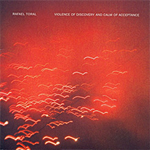|
|
 |
Dusted Reviews
Artist: Rafael Toral Album: Violence of Discovery and Calm of Acceptance Label: Touch Review date: Jan. 27, 2011 |

|
|
|
 |
"Drone" is the word writers and listeners use these days when dealing with music that deals in either extended, immersive tones, open-ended long-form works, or some combination of the two. Fifteen years ago, the word was "Ambient." Neither, unfortunately, really works for me, as they seem to be the end of analysis rather than the beginning. Rafael Toral knows this phenomenon well (his music has been described as both), and while he admits their usefulness as catch-all descriptors, he, too, is not satisfied with how they limit the music under discussion. “It describes only one aspect of sound, its duration, not its inner complexity and focus,” he said, in a 2006 interview in The Wire. “Can you imagine someone coming up with the term ‘short-note music’? Or, referring to piano music, ‘decay music’?”
Drone and Ambient are two labels that certainly do not apply to the music Toral has produced in the past decade, a concept of performance and research he has dubbed the "Space Program." But the quote above was directed more at the discussion that surrounded his pre-Space Program work, such as Wave Field, Aeriola Frequency and Violence of Discovery and Calm of Acceptance, originally released in 2001 and now reissued by Touch.
In many ways, Violence... is simultaneously a culmination as well as an overview of the decade or so Toral spent re-imagining the guitar. The 10 pieces here each trace their own slow trajectory through imperceptible harmonic changes, textural refinement and inaccessible machine-like logic. Some use a pointillist sense to build drawn-out melodies, some contrast glassy high-frequencies with bubbling undercurrents. Toral also utilizes the full spectrum of frequencies and dynamics, with rumbling lows and long, soft codas. The fact that the longest piece here is only eight and a half minutes, and most don’t top four, doesn’t stop each from evoking their own shade of wonder and charm.
So if not necessarily about duration and immersion, what are the 10 pieces here about? First of all, they are about resonance (the power of which Toral says he fully grasped after hearing Alvin Lucier’s “I Am Sitting in a Room”). That is, they explore how sound behaves in a space and how it in turn affects us psychologically. They are also about release, about not only how we interact with technology, but how we give up control and allow technology to interact among itself. In Toral’s case, that means how his guitars, filters and pedals all feedback and speak to each other, seemingly without intervention by him.
It’s in this undefined and unplanned communication that, despite their similar lengths, the real difference between a regular pop song or rock tune and a piece like, say, “Optical Flow” lies. It’s only three minutes long, but a moment-to-moment complexity and unpredictability emerges, even if the whole remains somehow stable and intuitive. Attention shifts from the macro to the micro level, perception keener but somehow more expansive. What music as rich and subtle as Toral’s teaches us on Violence... is that just because we don’t have the words ready or the tools at hand to describe and interpret the sounds, it doesn’t mean we should put off the search.
By Matthew Wuethrich
|







